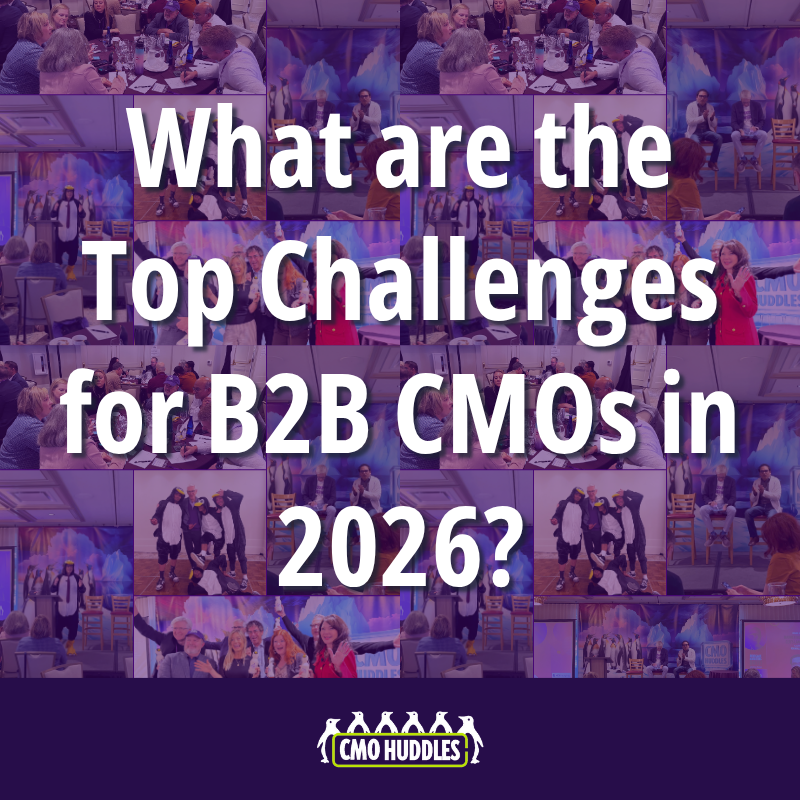At the CMO Super Huddle in Palo Alto, something magical happened. While penguins did not literally waddle through the El Prado Hotel, the spirit of huddling was alive and well. Picture one hundred of the sharpest B2B marketing leaders packed into a room, sharing stories, swapping secrets, cheering one another on, and occasionally shivering in unison at the mention of unpredictable budgets.
During one exercise, we asked attendees to write down two things on a small card (of course, there was a penguin image on the backside): their most significant strategic challenge and their biggest tactical challenge. We call these Big M (Marketing) and little m (marketing) challenges. Fifty-two CMOs took the prompt seriously and bared their souls in ink. The result is one of the most honest snapshots of what CMOs are actually struggling with right now. Real problems. Real anxieties. Real work that keeps even the bravest marketing penguins up at night.
This blog post brings those cards to life. It explains what the data revealed and why it matters. If you are a CMO, I have good news. You are not alone. And if you sell to CMOs, this might be the most valuable market research you read all year.
Let us dive in.
How We Collected This Rare Data
During the Super Huddle, we passed out small printed cards and asked each CMO to write two answers. One strategic challenge for the Big M (Marketing) column and one operational challenge for the little m (marketing) column. These cards came back filled with everything from existential brand struggles to cries for help about AI workflows.
We then categorized each response using a simple framework.
Big M = long term strategy, positioning, org structure, brand, GTM design, C-suite alignment.
Little m = execution, channels, AEO, pipeline operations, content, tactical AI, stack management.
The goal was to identify patterns. What keeps CMOs up at night strategically. What slows them down operationally. Where do these challenges overlap. And which CMOs could help each other most.
The result is a surprisingly clear picture of modern marketing leadership in 2025.
The Big M Challenges: Strategic Struggle In Full View
The Big M data was rich. Here are the themes that surfaced again and again.
1. Positioning and Brand Differentiation is the Number One Challenge
This was the number one Big M challenge. No contest.
Across industries and company sizes, CMOs confessed to struggling with differentiation. Some were dealing with rebrands. Others were trying to reposition after acquisitions. Several described brutally crowded categories where everyone sounds the same and buyers cannot tell competitors apart. A few were honest enough to say their product simply was not differentiated, and their challenge was to create clarity anyway.
Positioning remains one of the most misunderstood, underestimated, and underinvested areas of B2B marketing. And yet it is the foundation of everything. Without a compelling position, nothing scales. Not demand. Not brand. Not pipeline. Not sales velocity. This dataset reinforces that positioning is still the hardest part of the job.
2. AI and Organizational Transformation is Creating Massive Uncertainty
The second largest theme is perhaps the most telling. Nine CMOs described AI not as a tool but as a transformational force that is reshaping marketing from the inside out. Their challenges were pointed and sometimes existential.
• What should a modern marketing org look like in an AI first world
• Which roles will evolve and which may disappear
• How do we build an AI fluent team
• What breakthrough can AI enable beyond productivity gains
• How do we transform the org without breaking it
This was not about prompting. It was about rewriting the operating system of marketing itself.
3. Executive Alignment and Proving Marketing Value
Several CMOs expressed the need for deeper alignment with CEOs, CFOs, and CROs. Comments ranged from “my CEO does not understand marketing” to “I need to make marketing matter at the executive table.” One wrote about a persistent disconnect between long-term brand building and short-term revenue expectations. Another described being stuck in a tug-of-war with their CFO over which metrics matter.
This theme has been around for decades but is intensifying. With economic pressure rising and C-suite scrutiny at an all time high, CMOs are being forced to persuade and educate their own leadership teams. Many are doing Marketing 201 while their executives still judge them on Marketing 101.
4. Growth and Pipeline Strategy
Pipeline appeared throughout the dataset, but a handful of CMOs explicitly called it out as their top strategic challenge. They mentioned leaky funnels, inconsistent opportunity creation, and stalled revenue engines. They wrote about the need for sustained growth and the organizational pressure to deliver results faster than the GTM system can support.
As one CMO put it, “Pipeline is everyone’s problem now and somehow still only marketing’s responsibility.” This dataset supports that sentiment.
5. Org Design, Talent, Sales Alignment and Market Disruption
Smaller clusters appeared around org design, talent, culture, market disruption, sales alignment, and customer centricity. While not as dominant as positioning and AI transformation, these were still thoughtful, serious issues that reveal the expanding scope of the CMO role.
The takeaway is clear. CMOs must simultaneously be brand strategists, growth architects, AI futurists, organizational designers, GTM partners, and internal diplomats. That is a lot for any penguin to balance.
The little m Challenges: Tactical Tension Everywhere
The tactical challenges were just as telling. If Big M revealed where CMOs spend their mental energy, little m revealed where they spend their days.
1. AI Implementation and Workflows
The single largest tactical pain point was AI adoption. Fourteen CMOs wrote about agent workflows, operationalizing AI, team upskilling, tool selection, and the pressure to “do AI” without meaningful guidance. Some were battling AI search. Others were trying to implement agents across content, operations, or social. A few were struggling with internal resistance.
This aligns with what we hear every week in CMO Huddles. Every CMO is under pressure to adopt AI, but very few have an implementation roadmap. Even fewer feel confident explaining an AI strategy upward or downward. The mismatch between expectation and clarity is enormous.
2. GTM and Pipeline Execution
Pipeline did not only show up strategically. It dominated the tactical category as well. Six CMOs said their biggest little m challenge is funnel execution. They wrote about friction in the buying journey, slow opportunity progression, and GTM handoffs that feel more like hot potato than collaboration.
More telling, several wrote about the need for marketing to own much more of the revenue journey than ever before.
3. Messaging, AEO, and Search
This cluster ties directly back to positioning. When the strategic story is unclear, execution gets muddy. CMOs said their teams struggle to express differentiation, build AEO friendly content, and rise above the noise in markets where everyone is publishing the same playbook.
Search is changing fast. AEO is changing even faster. Many teams simply cannot catch up.
4. Team, Culture, and Executional Talent
Culture remains a meaningful executional challenge. Four CMOs talked about coaching, empowering their teams, and trying to build a more innovative mindset. Others wrote about upskilling teams to meet higher expectations in AI, data literacy, and disciplined execution.
5. Performance, ROI, MarTech, and Everything Else
These CMOs wrote about performance, attribution, and ROI pressure. Two wrote about martech sprawl. Several wrote one off tactical concerns that still showed where time is being consumed. The pattern is that CMOs are expected to lead the future while also fixing the mechanical issues of the present.
The Five CMO Archetypes Emerging From the Data
When we combined the Big M and little m themes, five clear personas emerged.
1. The AI Transformer
These CMOs worry about AI at both the strategy and execution levels. They feel pressure to redesign their org, their workflows, and their team skills. They know AI will reshape their role. They just need clarity on how.
2. The Positioning Architect
This group is wrestling with deep differentiation challenges and then struggling to express that differentiation through messaging, content, and AEO. They need a sharper story and a stronger megaphone.
3. The Revenue Engine Builder
These CMOs are rebuilding their revenue architecture from first principles. They struggle with growth strategy at the top and funnel mechanics at the bottom. This duality is shaping the hybrid CMO-CRO mindset.
4. The Executive Whisperer
Big M alignment issues. Little m ROI challenges. These CMOs are caught between proving value and translating marketing complexity into CFO friendly language. They must convince CEOs and CFOs to value marketing and also produce tactical ROI proofs to survive the budgeting cycle.
5. The People and Culture Shaper
These are the CMOs thinking about org design at the strategic level and team empowerment at the tactical level. They are rewriting the playbook for marketing talent in 2025.
These five personas describe the modern CMO better than any job description ever could.
What Vendors Should Learn From This Data
If you sell to CMOs, pay attention. This dataset reveals exactly what your buyers want right now and what they do not have the patience for.
CMOs want clarity
Do not pitch buzzwords. Explain real outcomes.
CMOs want speed
Shorter time to value beats sweeping transformation.
CMOs want proof
Case studies with quantifiable impact win every time.
CMOs want integration
No more point solutions that add friction.
CMOs want confidence
They need partners who make them feel smarter, faster, and more in control.
If your pitch is about complexity or disruption, you are swimming against the current.
What CMOs Should Learn From Each Other
The most reassuring part of this dataset is simple. You are not alone. That challenge you quietly worry about. Five, ten, or twelve other CMOs wrote almost the same thing. That feeling of being pulled into strategy while drowning in execution. Totally common. That struggle to reposition your company in a crowded category. Completely normal. That anxiety about AI taking your job while also demanding you reinvent your org. Shared by many.
This is the power of huddling. CMOs solve more when they think together. They move faster when they compare notes. They get braver when they hear others say, “Yes, I struggle with that too.”
Penguins survive because they huddle. So do CMOs. No one can face this environment alone and expect to thrive.
If there was ever a moment for CMOs to band together and find strength in shared insight, it is right now.
Don't go it alone. Join us. It’s warmer in here.

